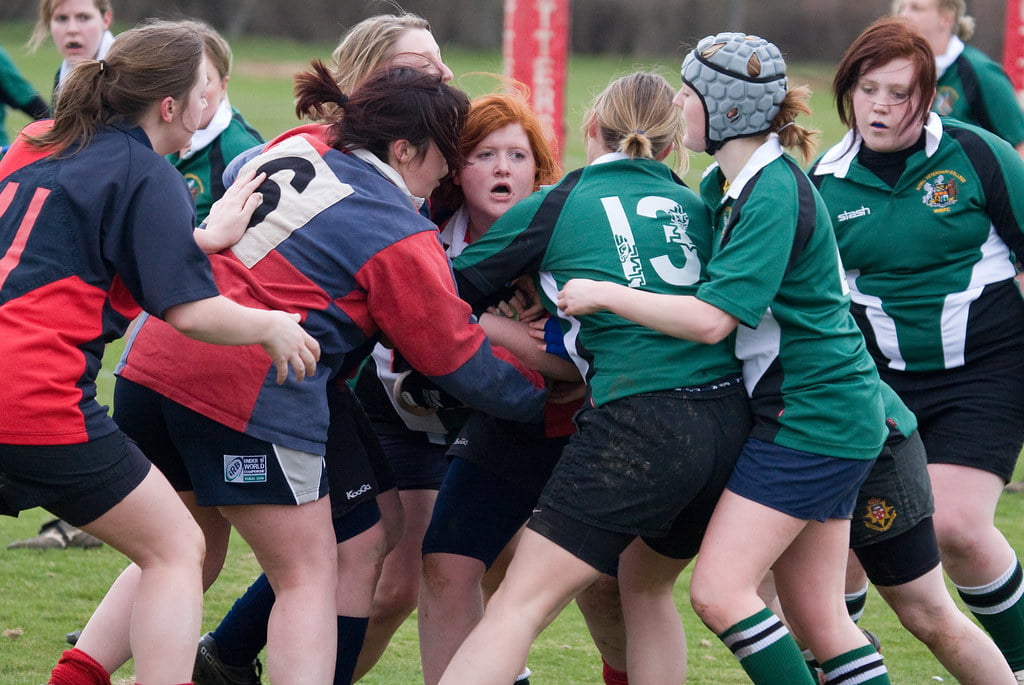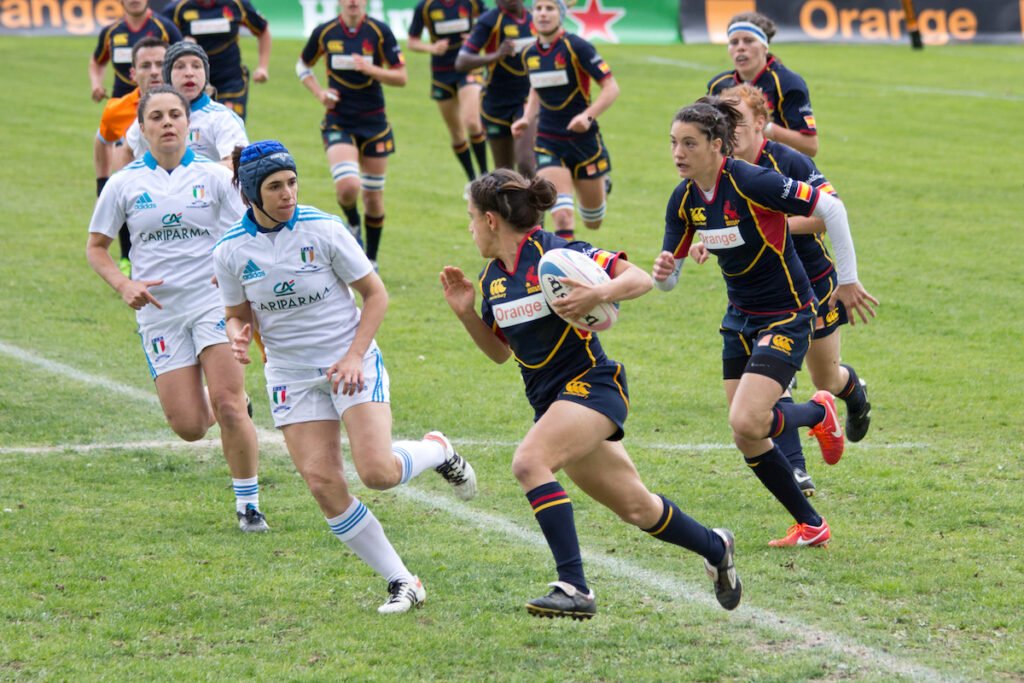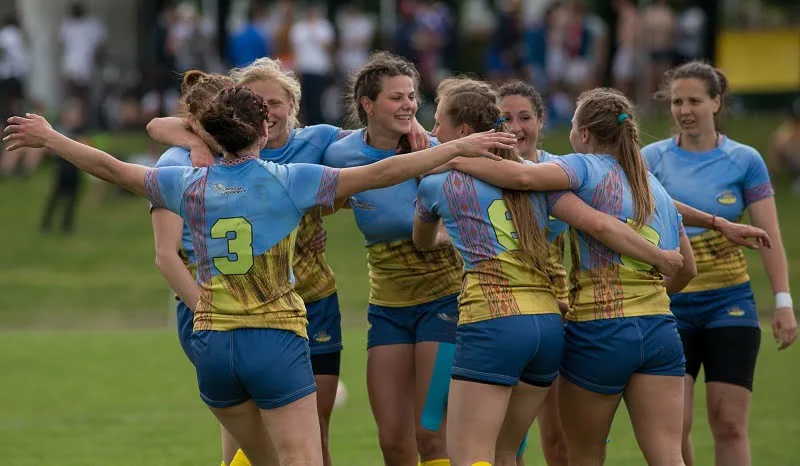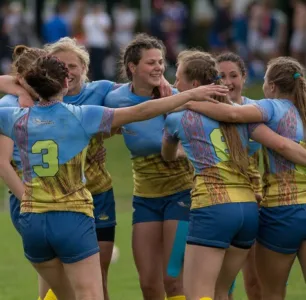A rugby team has 15 players on the field, and each position has specific skills, roles, responsibilities and physical requirements. Unlike football and other sports, players generally specialised in one position only. Players are split between forward and back positions.
The Forwards
- Loosehead prop
- Hooker
- Tighthead prop
- Second row (Lock)
- Blindside flanker
- Openside flanker
- Number 8
The Backs
Each position has specific responsibilities and skills required to play effectively.
The forwards
What is a loosehead prop
A loosehead prop plays in the front row of the scrum and typically wears the number 1 jersey. The loosehead prop is so named because their head is on the “loose” side of the scrum, meaning that it is not bound to the other players in the scrum. The primary responsibilities of the loosehead prop include providing stability in the scrum, providing a platform for the hooker to throw the ball into the lineout, and providing support in the carry and tackle. They also need to have good scrummaging technique, strength, and mobility to play effectively in this position.
What is a hooker in rugby
A hooker plays in the front row of the scrum and wears the number 2 jersey. The hooker’s main responsibilities include throwing the ball into the lineout, providing support in the scrum, and contesting for the ball at the breakdown. They also need to have good coordination, mobility, and technique in order to be effective in their role.

The hooker is a key link between the forwards and the backs and needs to be able to communicate well and work closely with their teammates. They also need to be strong, agile, and have good tackling technique in order to compete for the ball effectively in both scrums and open play.
Tighthead props
The tighthead prop plays in the front row of the scrum and typically wears the number 3 jersey. The tighthead prop gets their name because their head is on the “tight” side of the scrum, meaning that their head is “tight” held between the opposing Loosehead and Hooker.
The primary responsibilities of the tighthead prop include providing stability in the scrum, providing a platform for the hooker to throw the ball into the lineout, and providing support in the carry and tackle. They also need to have good scrummaging technique, strength, and mobility to play effectively in this position.
The tighthead prop is often seen as the cornerstone of the scrum and needs to be able to generate powerful pushes to help their team win the scrum. They also need to be able to hold their ground against the opposing tighthead prop, who is trying to push them backwards.
What is a second row in rugby
A second row, also known as a lock, plays in the second row of the scrum and typically wears either the number 4 or 5. The second row is responsible for providing height in the lineout, securing the ball in the scrum, and providing support in the tackle and carry. They also need to have good jumping ability to contest for the ball in the lineout, and good strength and mobility to compete for the ball in the scrum and open play.
Locks are often some of the tallest and heaviest players in the team, and they use their size and power to contest for the ball in the air and win the physical battles on the ground. They also need to be good tacklers and have the ability to make effective decisions in the tight situations that arise in the game.
The Flankers
There are two types of flankers: the blindside flanker, who wears the number 6 jersey, and the openside flanker, who wears the number 7 jersey. The flankers play in the forwards, usually on the sides of the scrum.
The primary responsibilities of the flankers include winning the ball at the breakdown, supporting the scrum, providing quick ball for the backs, and making tackles. They need to have good speed, agility, and tackling ability, as well as good communication skills, to play effectively in this position.

The openside flanker is often referred to as the “fetcher,” as they specialise in winning the ball at the breakdown and disrupting the opposition’s ball carriers. The blindside flanker, on the other hand, is often seen as the more physical player, providing support in the tackle and making the hard hits that can stop the opposition in their tracks. Both players need to have good endurance and work rate to keep up with the demands of the game.
The Number 8
A number 8 plays in the middle of the back row of the scrum. The number 8 is often seen as the link between the forwards and the backs, and they play a crucial role in the team’s attacking and defensive play.
The primary responsibilities of the number 8 include carrying the ball forward, providing quick ball for the backs, winning the ball at the breakdown, and making tackles. They also need to have good vision, passing skills, and decision-making ability, as well as good strength and mobility, to play effectively in this position.
The number 8 is often the player who picks up the ball from the base of the scrum and starts the team’s attack, and they need to have good pace and power to break through the opposition’s defense. They also need to be able to contest for the ball in the air and make tackles in open play to help their team defend their try-line. The number 8 is a key player in the team, and they need to be able to work effectively with their teammates to achieve success on the field.
The Backs
The Scrum half
A scrum-half, also known as a halfback, wears the number 9 jersey and plays in the back line, behind the forwards. The scrum-half is responsible for providing quick ball for the backs and controlling the flow of the game.
The primary responsibilities of the scrum-half include passing the ball out from the back of the scrum, providing quick ball from the rucks and mauls, and making accurate passes to the backs to initiate attacking moves.

They also need to have good decision-making skills, vision, and an ability to read the game to be effective in this position. The scrum-half is the player who usually receives the ball from the lineout and is responsible for starting the team’s attack. They need to have good pace and evasion skills to make the most of any opportunities that arise, and they need to be able to defend effectively to protect their try-line. The scrum-half is a key player in the team, and they need to be able to work effectively with their forwards and backs to achieve success on the field.
The Fly Half
A fly-half, also known as a first five-eighth, wears the number 10 jersey and plays in the back line, behind the forwards. The fly-half is responsible for controlling the team’s attacking play and making important decisions on the field.
The primary responsibilities of the fly-half include making accurate passes to initiate attacking moves, kicking for goal, and controlling the team’s territorial play through tactical kicking. They also need to have good decision-making skills, vision, and an ability to read the game to be effective in this position.
The fly-half is often seen as the playmaker in the team, and they need to be able to bring their forwards and backs together to create scoring opportunities. They also need to have good communication skills, as they are often the player who is responsible for relaying instructions from the coach to the other players on the field. The fly-half is a key player in the team, and they need to be able to work effectively with their scrum-half, centres, and wings to achieve success on the field.
The Centres
A centre, also known as a midfielder, is a position in rugby union. They wear the number 12 or 13 jersey and play in the back line, behind the forwards. Centres are usually the team’s primary attacking weapons, and they play an important role in both attack and defence.
The primary responsibilities of the centres include carrying the ball forward, making tackles, and creating scoring opportunities for their team. They also need to have good hands, passing skills, and an ability to read the game to be effective in this position. The centres are often the players who run with the ball in open play and make the breaks that can lead to tries. They need to have good pace, power, and evasion skills to get past the opposition’s defence, and they need to be able to defend effectively to protect their try-line.
Rugby Wingers
A winger is a position in rugby union. They wear the numbers 11 or 14 jersey and play in the back line, behind the forwards. Wingers are usually the team’s primary attacking weapons and are responsible for finishing moves and scoring tries.

The primary responsibilities of the wingers include running with the ball in open play, finishing moves to score tries, and making tackles in defence. They also need to have good pace, power, and evasion skills to get past the opposition’s defence, and they need to be able to defend effectively to protect their try-line. The wingers are often the players who run onto the ball from deep positions, and they need to have good timing and acceleration to get past the opposition’s defence. They also need to have good hands, as they are often the players who receive the final pass before scoring a try.
Fullbacks
A full-back is a position in rugby union. They wear the number 15 jersey and play in the back line, behind the forwards. The full-back is responsible for providing cover in defence, counter-attacking, and creating scoring opportunities for their team.
The primary responsibilities of the full-back include making tackles, organising the defence, and starting counter-attacks. They also need to have good catching and kicking skills to be effective in this position.
The full-back is often the last line of defence, and they need to be able to make tackles and prevent opposition players from scoring tries. They also need to have good pace, power, and evasion skills to make the most of any counter-attacking opportunities that arise.
The full-back is responsible for starting many of the team’s attacking moves, and they need to have good decision-making skills, vision, and an ability to read the game to be effective in this role. The full-back needs to be able to work effectively with their wingers, centres, fly-half, and scrum-half to achieve success on the field. The full-back is a crucial part of the team, and their performance can have a significant impact on the outcome of the game.
How many substitutes are allowed in rugby

In rugby union, a team is allowed to make a maximum of 8 substitutions. This means that a team can replace up to 8 players during the course of a match. The substitutions can be made at any time, although the players being replaced must leave the field before their replacements can come on. The number of substitutions in rugby has been increased over the years to help manage player welfare and reduce the risk of injury.
In some domestic competitions and lower-level games, the number of substitutions allowed may be different. The rules and regulations for substitutions can vary between competitions, so it’s important to check the specific rules for each game.

